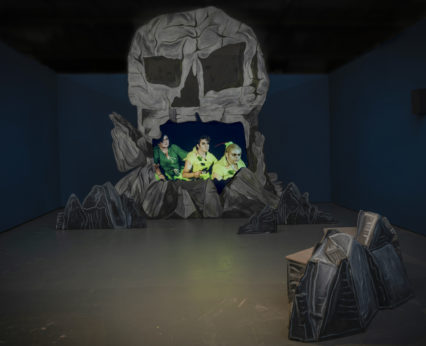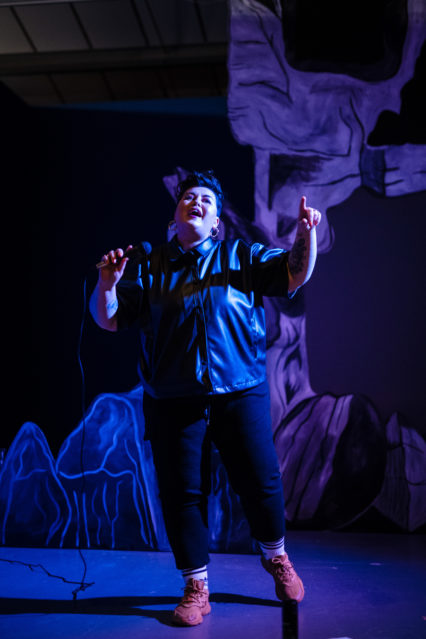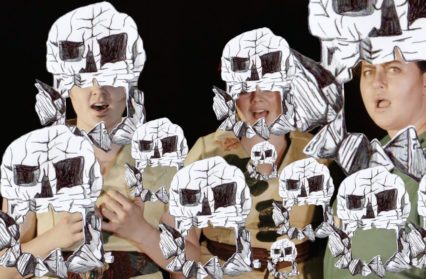Joshua Jones talks to artist Kath Ashill to find out about their latest work Principal Boy, which recently showed at G39 in Cardiff.
A principal boy, in theatre, is the romantic hero of the story; a boy played by a woman. The actor retains their femininity, rather than impersonating a man, and were allowed to present their beauty, in an era — the Edwardian and Victorian periods — renowned for its modesty and restrictions. Women — playing boys — could wear short, flattering costumes, display their legs, slap their thighs upon entrance, inadvertently blurring the lines between the sexes; obscuring sexuality and attraction.
Kath Ashill’s latest work, Principal Boy, opened at G39, Cardiff in the Autumn of 2022. The show, composed primarily of video installation and portraiture, uses the history and culture of the principal boy to explore Ashill’s gender and identity. I visited the exhibition preview, and was swept by the physicality of the show. The projection screen was framed by a hand-painted set, recreating Skull Island from Peter Pan, and the division of the gallery space into a bar/lobby area on one side, and performance area on the other, with a corridor acting as a transitory space between the two, allowed for what felt like a guided, controlled experience through the space. The heavy, blue theatre curtains presented a degree of solemnity, of expectation, but the film was slapstick, deliberately amateurish, playfully engaging with its subject matter.
Originally from Pontardawe, Ashill (who uses they/them pronouns) has been working as an artist since the mid-2000s. Amateur dramatics, the drag king scene, and autobiography are recurring themes in Ashill’s work, which she uses to explore and navigate gender identity, through DIY costume and stage design and theatricality. I spoke to them after the exhibition about Principal Boy, their past work, gender, Welshness and more.
From my experience of your past work, it appears there’s a common thread between Principal Boy and your earlier work, such as Fool’s Gold. Are they in conversation? Do they build upon or deviate from each other?
I think they are definitely linked; Fool’s Gold and Principal Boy act as sibling pieces. I played every male role in Fool’s Gold, and it galvanised my experiences of drag. I’ve been doing drag throughout my art career without realising I was doing drag. Through making Fool’s Gold, I struck up a connection with Len, a successful and exciting drag king from Cardiff — I was looking for a Welsh drag king and their name kept coming up, and they became a huge part of Principal Boy.
I originally created Principal Boy as a live performance for a radio art performance festival at Glasgow called Radiophrenia; the script and dialogue are almost identical. I also planned to make a film but I was heavily pregnant and still quite femme presenting. In my head I complete envisioned myself as a boy, so there was a real disconnect between how I saw myself and how others saw me. Principal Boy is me pursuing my masculinity, and my personal histories of masculinity, so while I enjoyed being pregnant, the physicality of my pregnant body wasn’t what I imagined for the film. I ended up putting

Principal Boy to rest, which made it really nice to come back to. In terms of installation, I became obsessed with framing films in a set to aid the theatricality and spectacle of the overall work. Making a connection between the hand-painted animation with the film visuals. I’m obsessed with spectacle and the narrative it contains — like theme parks, haunted houses, escape rooms.
Your perception and exploration of gender is at the forefront of Principal Boy – through costume, make-up, facial hair, the roles yourself and the actors occupy. Has that always been present in your work, or a more recent development?
No, that’s always been there in my work. I’ve always been aware of gender, even as a child, although I didn’t have the language for it at the time. I was obsessed with Victoria Wood, and I wanted my hair cut like her, an undercut with a bob. I remember being eight, walking around in a pink blazer and a tie. I used to enter myself into talent competitions on family holidays – Butlins and Havens Holidays — and I’d win loads of prizes. I think that was my first forays into comedy and theatrics.
Growing up in Pontardawe, there were crude gender roles. I was brought up in rugby clubs, an inter-generational social space — a highly masculine social space. You could only hang out with the boys if you were pretty or had banter, were allowed to be there if you could make people laugh. I had a paper round too and was always mistaken for a boy. Having a boyish haircut meant I’d also be asked to play boys’ roles in drama. I came out in 2002 – it was a very different landscape then, more rigid and discriminatory, unlike now. We still use terms like “butch” to put people into boxes, but they mean less now.
Your work is often very colourful — from the garish colours of glitter and tinsel (e.g Brush me, Floss Me, or Lose Me), to the bright silver, lilac and gold costumes of The Chorus — it’s clear than colour is integral to your work, and there’s no exception in Principal Boy. How do you consider the use of colour, and what does the use of blue mean to you within the work?
I see my work in themed categories. Colour and playfulness come from my experiences of amateur dramatics, and the

shambolic nature of costume design. I was part of this am-dram group in Bishop Briggs, just outside of Glasgow. I was never allowed to have a speaking part because I didn’t have, and couldn’t do, a Scottish accent, so I would usually play the part of a lovelorn young boy, who was often dying! Their costumes and props were madly creative and handmade, like monsters made out of shopping trolleys and bicycle lights. It made sense for me to combine that with drag — drag has a long history of handmade outfits, events posters, publications, the whole DIY attitude.
I first used blue predominantly for Poster Boy, playing with that old trope of blue is for boys. I went to a Yves Klein retrospective in 2006, and while I love his work, I think there’s a potent toxic masculinity in claiming a colour. Those things have an influence of you; that I may have been reproduced to a torso, or a dismembered body part, because of my gender. I think blue, and the history of blue, feeds into my need for, perhaps crudely, claiming masculinity for myself.
As Dylan Huw writes in his essay, ‘GLASLENCYNDOD’, for Principal Boy: curtains denote something hidden, but when made oversized and ornate blue, that “hiddenness becomes a joke, daring you to come and see”. He also notes that the space feels “fabulous, alien, discomforting”. How do you play with audience’s perception of what’s hidden? Their discomfort? How do you negotiate an audience within the space?
There’s often a quiet discomfort within live performance, for the performer(s) as well as the audience. I try to smile, make eye contact, to let the audience know I’m there with them. I’m not quietly detached from the moment. I’ve been working publicly as an artist since 2007, and I remember the performance trope of the time was to not engage with the audience, pretend they’re not there.
Crossing a threshold in itself can be quite discomforting. Creating a space, and then asking people to enter that space, hopefully creates intrigue rather than another barrier to art. I wanted to divide the space at G39, so the audiences are negotiated through the show. That comes from what I enjoy from a performance – I like to be instructed on where to go, from start to finish. I don’t like being left to meander.
You have previously spoken about experiencing a feeling of in-betweenness in whichever environment you are working in. Principal Boy, and your multimedia way of working, attempts to deconstruct and present that in-betweenness, essentially creating your own space, a new environment. Is that new space solely for you to live in, or for others to join you within it?
Creating that space serves both functions. Making Principal Boy was a cathartic experience; it is almost like the presentation of a mid-life crisis: it’s me coming to terms with being in my late 30s, and this weird feeling of being in-between youth. It feels like only yesterday I was 20. Change is frightening, exciting, intimidating. Principal Boy is also me making sense of my being in masculine spaces, which has become more apparent as I get older, and I occupy a changing body, becoming a larger, plus-sized body, that moves differently through society than a slimmer, more feminine-presenting body. I also feel like I exist in both spaces, femininity and masculinity, but I can’t commit.
That happens in many arenas in my life, such as my Welshness — which Dylan picked up on with his essay. I’m Welsh, and I was brought up speaking Welsh, but my mother’s background is Jewish, who’s family emigrated, to escape pogrom, and went to Swansea because it was the only place in Wales with a synagogue. My great-grandmother was the last practising Jew in our family. I feel closeness to both my Welsh and Jewish heritage, but disconnected also — sometimes it feels like my Welshness is as shallow as a puddle, but it’s everything too.












